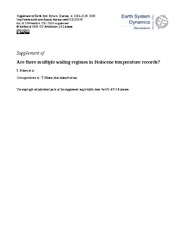Are there multiple scaling regimes in Holocene temperature records?
Permanent link
https://hdl.handle.net/10037/8449Date
2015-07-17Type
Journal articleTidsskriftartikkel
Abstract
The concept of multiple scaling regimes in temperature time series is examined, with
emphasis on the question whether or not a mono-scaling model can be rejected from
the data at hand. A model with only one regime is simpler and is preferred if this
5 explains the observed variability. Our analysis of spectra from reconstructed air temperature
from Greenland and Antarctica ice cores shows that a scale break around
centennial time scales is evident for the last glacial period, but not for the Holocene.
Nor by analysing a number of late Holocene multiproxy temperature reconstructions
can a significant scale break be identified. Our results indicate that a mono-scaling
10 model cannot be rejected as a null model for the Holocene climate up to at least millennial
time scales, although it can be rejected for the glacial climate state. The scale
break observed from the glacial time ice core records is likely caused by the influence
of Dansgaard–Oeschger events and teleconnections to the Southern Hemisphere on
centennial time scales. From our analysis we conclude that the two-regime model is
15 not sufficiently justified for the Holocene to be used for temperature prediction on centennial
time scales
Publisher
Copernicus GmbHCitation
Earth System Dynamics Discussions 6(2015) s. 1201-1235Metadata
Show full item recordCollections
The following license file are associated with this item:


 English
English norsk
norsk